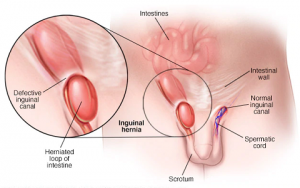Dr. Harshad Mahatme - Hernia Surgeon in Nashik
WHAT IS HERNIA?
Dr. Harshad Mahatme is a Gastrointestinal, Bariatric and Hernia Surgeon in Nashik. He had 14 years of experience in these fields. He practices at Sankalp Speciality Healthcare Private Limited in Tidke Colony, Nashik. He is the best doctor for hernia in Nashik and also done with 3000 successful hernia surgeries in Nashik.
Hernia happens when the inside layers of the abdominal wall weaken, bulge or tear. The inner wall of the abdomen pushes into the weakened area to form a balloon-like sac. Thus, change can cause a loop of intestine or abdominal tissue to slip into the sac, causing severe pain and other serious health difficulties.

Women and Men of any ages can have hernias. Hernias usually occur either because of a natural weakness in the abdominal wall or from too much strain on the abdominal wall, such as:
- Strain from heavy lifting
- Gaining a great deal of weight
- Persistent coughing
- Difficulty with bowel movements or urination.
- Muscle weakness as in old age
INNOVATIVE
- Laparoscopic hernia surgery
- Abdominal wall reconstruction in very large hernia.
TYPES OF HERNIA
1.hiatal hernia
A hiatal hernia happens when the upper part of your stomach protrudes through the large muscle departing your abdomen and chest. Your diaphragm has a tiny opening (hiatus) through which your food tube transfers before attaching to your abdomen. In a hiatal hernia, the abdomen forces up through that opening and into your chest.

2.Inguinal hernia
An inguinal hernia occurs when a muscle, part of the intestine, protrudes into a light spot in the abdominal muscles. The resulting bulge can be painful, mainly when you cough, turn over or lift a heavy object. An inguinal hernia isn’t certainly critical. It doesn’t change on its own, however, and can start to life-threatening difficulties.

3.Umbilical hernia
An umbilical hernia happens when part of your intestine holds out by the opening in your abdominal muscles through which your umbilical cord passed before you born. Umbilical hernias are common and typically harmless. They are most common in children, but they can affect adults as well. In a baby, an umbilical hernia may be mainly visible when the child cries, causing the belly button to protrude. This is a typical sign of an umbilical hernia.

4.Incisional Hernia :
Hernia ( bulge) at the site of previous abdominal surgery is known as incisional hernia its due to give way or cut through of previous surgery stitches. It require surgery at earliest as waiting for long time increases the defect size and chances of recurrence increases as defect size increases. Its always repaired with mesh.

SYMPTOMS
- A noticeable protrusion (bulge) in the groin area or the abdomen.
- Feeling pain while lifting.
- A dull aching or burning sensation.
- A vague feeling of fullness.
- Nausea and constipation.
DIAGNOSIS
HITAL HERNIA
- X-ray of your upper digestive system.
- Upper endoscopy – inserts a thin, flexible tube equipped with a light and camera (endoscope) under your throat.
- Esophageal manometry – This test measures the rhythmic muscle contractions in your esophagus during you swallow.
INGUINAL HERNIA:
- check for a bulge in the groin area. If the diagnosis isn’t readily clear, your doctor Says to you an imaging test, such as an abdominal ultrasound, CT scan or MRI.
UMBILICAL HERNIA
- An umbilical hernia is diagnosed throughout a physical exam. Sometimes imaging studies abdominal ultrasound or a CT scan are used to screen for difficulties.
TREATMENT
Open hernia repair
Surgery usually done under spinal or general anesthesia depending on location of hernia. Incision usually taken over hernia site and hernia usually repaired with prolene mesh to prevent recurrence.
Laparoscopy
In this minimally invasive method, which needs general anesthesia, the surgeon operates through several small incisions in the abdomen. Gas is used to expand your abdomen to make the internal organs easier to see.
A small tube equipped with a tiny camera (laparoscope) is inserted into one hole. Guided by the camera, the surgeon inserts tiny tools through other cuts to repair the hernia using synthetic mesh.
